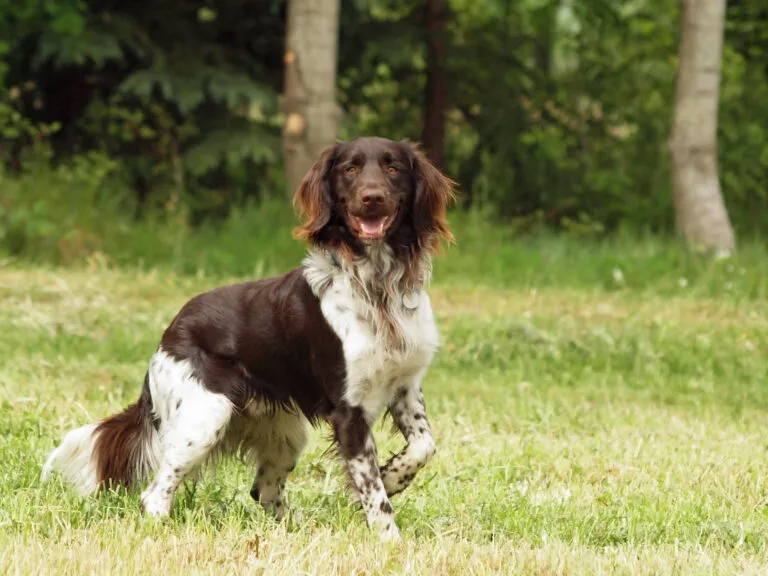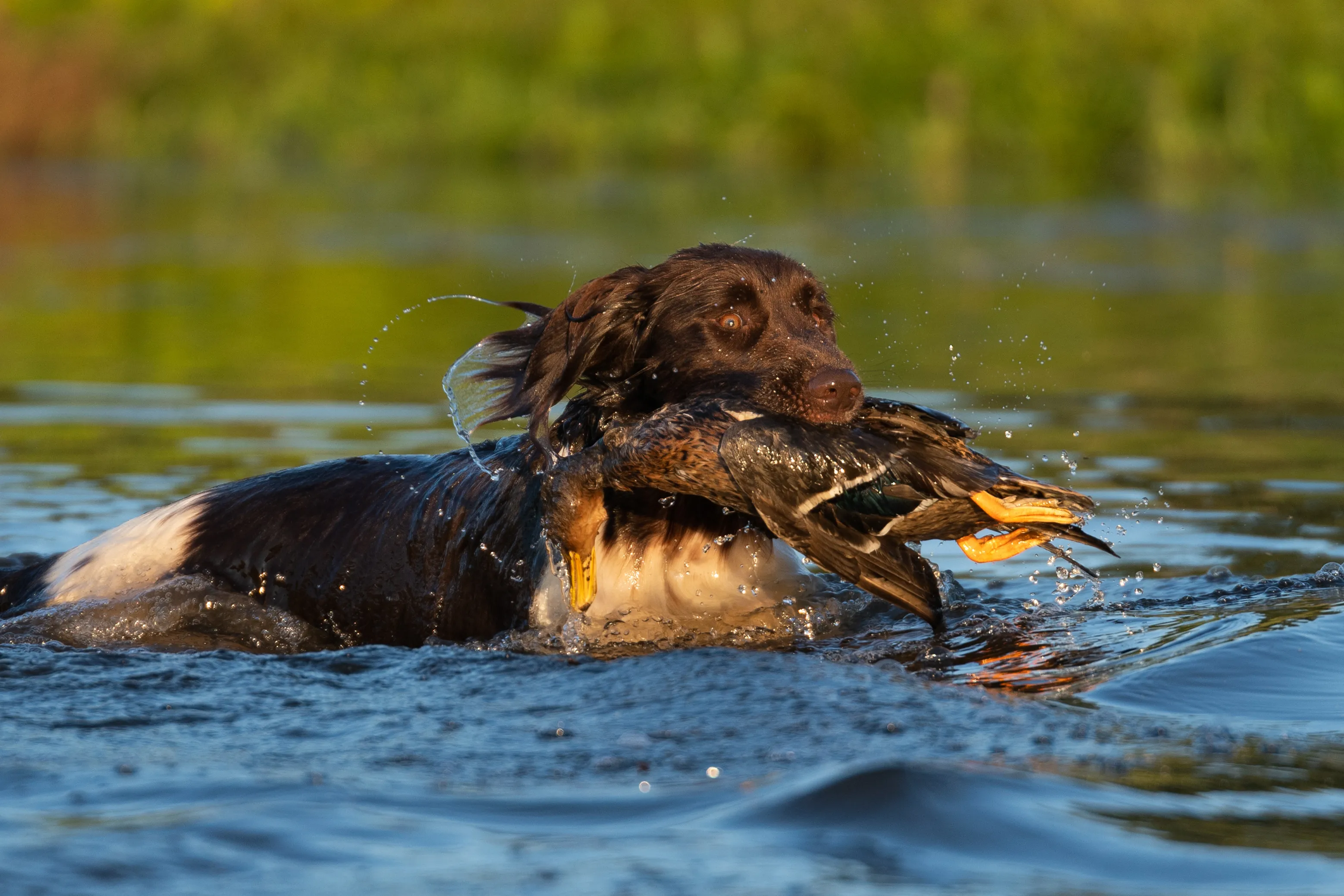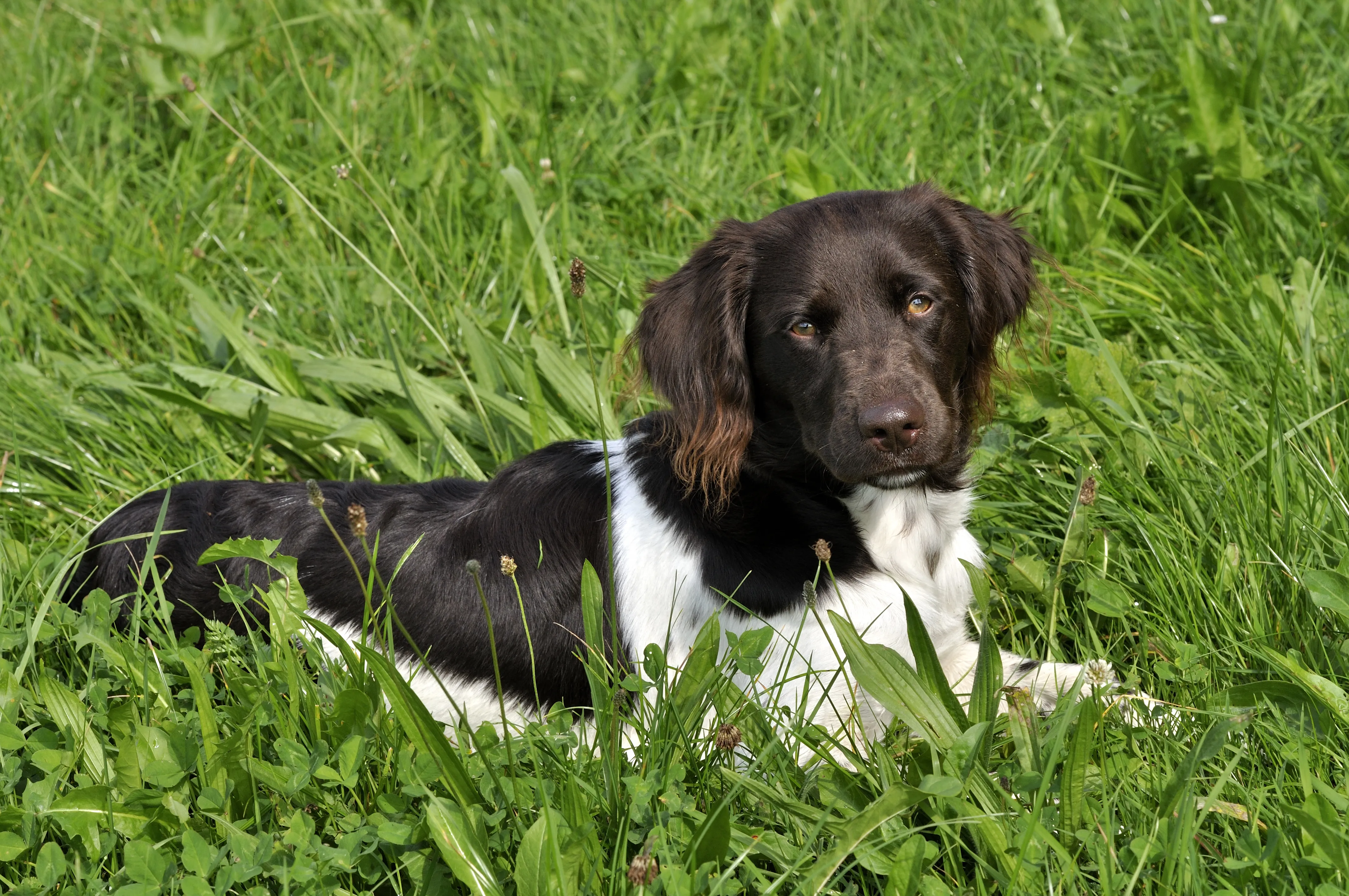Beagle
The Beagle's short legs can be deceiving – this medium-sized dog keeps you on your toes and is always full of surprises! This friendly breed is active, fearless and extremely clever.
These dogs are defined by many positive qualities and are also very pleasing on the eye. This leads to more and more people wanting to keep Small Münsterländers solely as companion dogs. However, the Small Münsterländer is primarily a hunting dog for hunters. We will introduce you to these versatile gun dogs.

© Alexandra Hollstein / stock.adobe.com
With a shoulder height of up to 54cm, the Small Münsterländer is one of the smallest pointer dogs. Females reach up to 52cm in height. Dogs of this breed weigh a maximum of 24kg and have a well-proportioned physique. In terms of appearance, these elegant dogs are reminiscent of fellow hunters like the Large Münsterländer and French Spaniel. Its coat is medium-length and slightly wavy or smooth. The front and rear legs are partly feathered, i.e. long-haired. The fur is also more abundant on the long tail, with experts describing it as like a flag. Overall, according to the standard, the fur should not obscure the dog’s contours. Small Münsterländers are white or mottled with brown or liver-coloured markings in the form of dots, panels or a type of cloak.
Nomen est omen: The Small Münsterländer comes from the picturesque Münsterland region close to the city of Münster in North Rhine-Westphalia. Quail dogs characterised by good pointing and retrieval abilities have lived here for centuries. The forester and canine researcher Edmund Löns expanded targeted breeding of the Small Münsterländer from 1902 based on these hunting companions. He gave the resulting breed the nice name ‘Heidewachtel’, which in German refers to the most significant area of deployment of these hunting dogs: hunting quail (Wachtel) on the heath (Heide). Löns paired these dogs with specimens from the hunting dog line Dorstener Stamm from Coesfeld. There was some disagreement when it came to finding a name, since Löns did not like names like gun or quail dog. In the end, the name Small Münsterländer Pointer prevailed. The first breed standard was established in 1921.
By the way, the Small Münsterländer has nothing in common with the Large Münsterländer in terms of breeding. Although the latter also comes from Münsterland and enjoys hunting, it is a colour variant of the German Longhaired Pointer and has become a stand-alone breed. The Small Münsterländer is more closely related to the French Spaniel. Nowadays, these four-legged hunting assistants aren’t just found in Germany, but France, Belgium and Scandinavia too. In comparison, it is still rarely found in Britain. The increasing popularity in some countries does bring some disadvantages, though: Many unscrupulous breeders target a quick profit and show little regard for healthcare provision or finding suitable interested parties. The Small Münsterländer is under-stimulated purely as a family dog.
 © sebgsh / stock.adobe.com
© sebgsh / stock.adobe.com
With species-appropriate stimulation, the Small Münsterländer is an even-tempered and friendly four-legged friend towards people and fellow dogs. It forms a close bond with its caregiver and enjoys bonding socially with other dogs too. If it can put its work ethic to use, it will feel perfectly happy in its leisure time with its family and will be calm and gentle at home. The Small Münsterländer is very attentive and adventurous outdoors. Its innate work ethic also includes constant alertness to predators. When hunting, it is highly concentrated and persistent with nerves of steel. It is also a good swimmer.
The Small Münsterländer is a quick and able learner. This doesn’t necessarily mean that training is a piece of cake, because these intelligent canines recognise the smallest signs of uncertainty from their caregiver and happily exploit them if they can gain an advantage. Hence, they need consistent and assured leadership. The Small Münsterländer’s intelligence and love of learning make it a docile and motivated pupil. It should complete hunting dog training with the related exams. Training is very intensive during the first two years of age, but you will benefit from this in the subsequent years in the fields and forests. A budding hunting dog can also benefit from puppy school. At the same time as the basic training, you can take the first steps into future hunting life with your dog. Retrieval or exercising in water, dragging and flushing work are other first stages on the way to becoming a hunting dog.
If you take on a Small Münsterländer from a reputable breed, your chances of getting a healthy dog are good. A fit Small Münsterländer fed in a species-appropriate way can reach an average age of 15 years. The breed is considered robust, but it can be prone to certain diseases in isolated cases – especially if a dog’s breeder attaches little importance to good healthcare provision and appropriate parent animal selection. The Small Münsterländer is prone to health problems such as atopic dermatitis, an allergic skin reaction. Joint problems such as hip dysplasia are rarer.
You can prevent both skin and joint problems by offering a balanced dog food and keeping your four-legged friend in shape. Like all dogs, the Small Münsterländer also needs a high-quality diet that provides protein. Bear in mind that treats – even tiny tidbits during training – should be calculated as part of your dog’s overall consumption for the day.
Rumen or dried chew bones are a tasty occasional treat that you should reward your dog with every now and then. As a tip, you can train your dog to stay alone with such nibbles. Hand your dog a pungent piece of rumen and disappear without warning for a few minutes. Chew snacks are a welcome distraction and make the time without you go quicker. Make sure that your Small Münsterländer always has enough drinking water freely available.
Discover our selection of dog food!
The Small Münsterländer’s plain fur is low-maintenance and brushing it every few days is sufficient. The fur protects your dog from thorns and undergrowth, but some things do get caught in it. You should check for ticks, burs and other remnants from walks in the woods. You’re best off brushing your dog’s fur more regularly during the moulting period. This way you are supporting your dog and minimising the amount of hair scattered around your home. You should pay particular attention to your Small Münsterländer’s lop ears, because infections can develop there quicker than on average. Clean them regularly with a canine ear cleaner and take your companion to the vet at the first signs of an infection. Dogs that walk a lot on soft forest floors are prone to long claws, which carry a risk of painful injuries. Get your vet to show you how to cut long claws with claw clippers.
These pointer dogs are compact all-round hunters. They love quarrying, searching and retrieving. The Small Münsterländer should definitely undergo hunting dog training and then be deployed in forests and fields. They are also excellent pack hunters if they have been accustomed to this for a young age. Since they like water, they are well suited to retrieval from water and hunting ducks. A Small Münsterländer regularly deployed for hunting is even-tempered and satisfied. As an addition or alternative to hunting, some Small Münsterländers enjoy learning agility. Many dogs of this breed also like man-trailing. These intelligent and agile four-legged friends are suited for numerous types of dog sport when they reach adult age.
 © motivjaegerin1 / stock.adobe.com
© motivjaegerin1 / stock.adobe.com
The Small Münsterländer is best suited to professional or leisure hunters looking for a family-friendly dog. It lives harmoniously in a family home. It’s best if the house is located in the countryside. The Small Münsterländer is only happy in cities if it is allowed to be out and about regularly. So if you live on a third floor in the the middle of the city, you’re best off choosing dog breeds that can cope better there. Keeping these sociable dogs in a kennel isn’t recommended.
These dogs need plenty of commitment. With insufficient stimulation and hunting – or an alternative dog sport – the Small Münsterländer sets itself different objectives such as chasing passing cyclists. Only people with plenty of time for activity and training for these dogs should consider making a Small Münsterländer part of their family. There shouldn’t be any small pets living in the household either, because rabbits and the like are primarily interesting prey for hunting dogs. Living with cats is only recommended with reservations too – for instance, if a puppy is already acquainted with cats. Cats and dogs can then make a dream team. However, your dog accepting felines in its family doesn’t mean that it won’t chase after the neighbours’ cat. So if you have a garden, it’s best to fence it to make it escape-proof.
These dogs usually get on great with children. However, as with all dogs, never leave them unsupervised with children and allow them opportunities to retreat in case the hustle and bustle gets too much for them.
Bear in mind that a dog doesn’t just need plenty of time, but generates ongoing costs too. A Small Münsterländer from a reputable breeder will cost a four-figure sum. In addition to this, there may be complete basic equipment for dogs as well as ongoing expenses. These include the costs of high-quality food, dog tax and liability insurance, as well as check-ups at the vet. Organise holiday care provision in advance too and sort out who will take care of your dog should you be ill for an extended period. If your Small Münsterländer is well-trained, you can take it with you to many hotels and go on wonderful hikes together.
Since Small Münsterländers are quite popular, you will generally be quick to strike lucky if you wish to take a dog of this breed into your home. Definitely opt for a reputable breeder: This is the only way you will get a dog that has verifiably healthy parents and has been reared responsibly. The breeder should belong to an association and be prepared to give you information without any reservations on the healthcare provision for their dogs. Represented in 12 countries, the Verband Kleine Münsterländer International (abb.: KIM-I) is a good port of call for interested parties looking for a suitable breeder in Europe and the US. For instance, if you’re looking for a Small Münsterländer in Germany, you can contact the German association’s puppy placement service. Moreover, older Small Münsterländers that have lost their previous home are rehomed through the association from time to time.
With good reason, most breeders only give their puppies away to hunters. A good breeder will invite you to see puppies in their home. This doesn’t just give you valuable insights, but the breeder also has the opportunity to get to know you better. After all, they only want their charges to be in responsible hands. If you aren’t a hunter but have fallen for the breed, look at crossbreeds in animal shelters that have lost their home for different reasons. You can often find similarly charming-looking four-legged friends there. Inform yourself thoroughly about the dog’s character in advance to find out if you will be a good match for one another.
We wish you happy hunting at all times with your Small Münsterländer!
The Beagle's short legs can be deceiving – this medium-sized dog keeps you on your toes and is always full of surprises! This friendly breed is active, fearless and extremely clever.
The Golden Retriever is still one of the most popular dog breeds, especially with families. It is defined not just by its docility, but shows numerous other qualities too. Read in the following article everything you need to know about the Golden Retriever.
The German Shepherd is one of the most popular utility dog breeds in the world, though the willing-to-learn and people-focused nature of these versatile dogs also makes them suitable for family life.